Originally Published on October 17, 2018. Last Updated on September 15, 2023.
For nearly three centuries, rocking chairs have been preferred settings for watching sunsets, soothing infants, and chatting with friends and neighbors.
The rocking chair comes from humble beginnings, originally designed with a simple wooden frame supported by two slopped runners. However, the design has morphed and multiplied over the last 300 years. Now there’s a dizzying assortment of styles, materials, and colors to wade through to find the one you want. This can make the shopping process less than fun.
Fortunately, we’ve collected our considerable knowledge about this classic outdoor furniture item in one place so you can buy a rocking chair with confidence.
Jump To Section
Step 1: Will a Rocking Chair Work for Your Outdoor Space?
Step 2: Start With How Much Space You Have
Step 3: Decide on a Material Type
Step 4: Choose a Style That Fits Your Space
Step 5: Pick the Right Color
Step 6: Accessorize
Trex Outdoor Furniture Rocker Comparison
Step 1: Will a Rocking Chair Work for Your Outdoor Space?
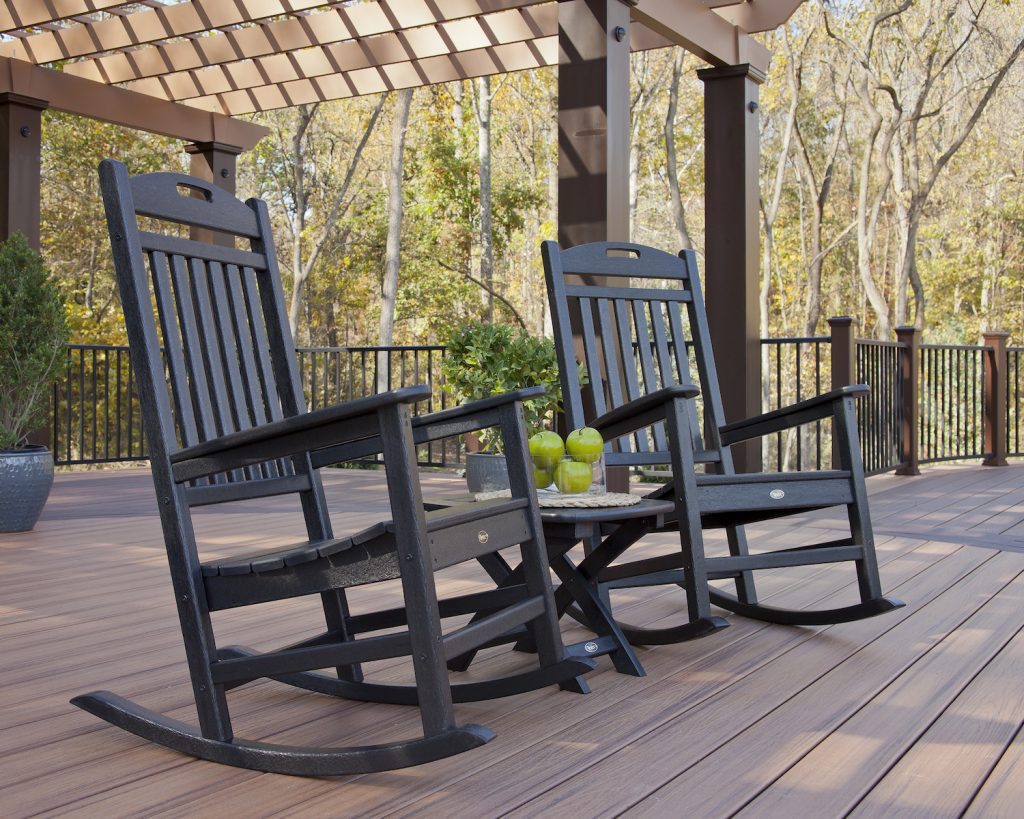
One of the first things to determine is whether or not a rocker will work in your outdoor space. Here are some factors to consider that will lead you to the right answer.
- Floors: An outdoor rocker works best on smooth, flat surfaces like concrete, tile, and decking. Grass, gravel, cobblestone, or other uneven surfaces will impede the chair’s movement.
- Weight: Depending on the material, rocking chairs can get pretty heavy. You may need assistance to move them. But you’ll want something with enough heft to withstand strong winds.
- Seat height: Some individuals may have trouble getting in or out of chairs that sit low to the ground. If this is the case for you or a loved one, look for rockers with higher seats.
- Durability: If your space is completely open and exposed to the elements, you’ll want rockers that can handle all weather conditions in addition to repeat use.
Step 2: Start With How Much Space You Have
Rocking chairs take up more space than you realize. Not only do you need room for the seat itself, but you must also account for the clearance required to accommodate the back-and-forth motion.
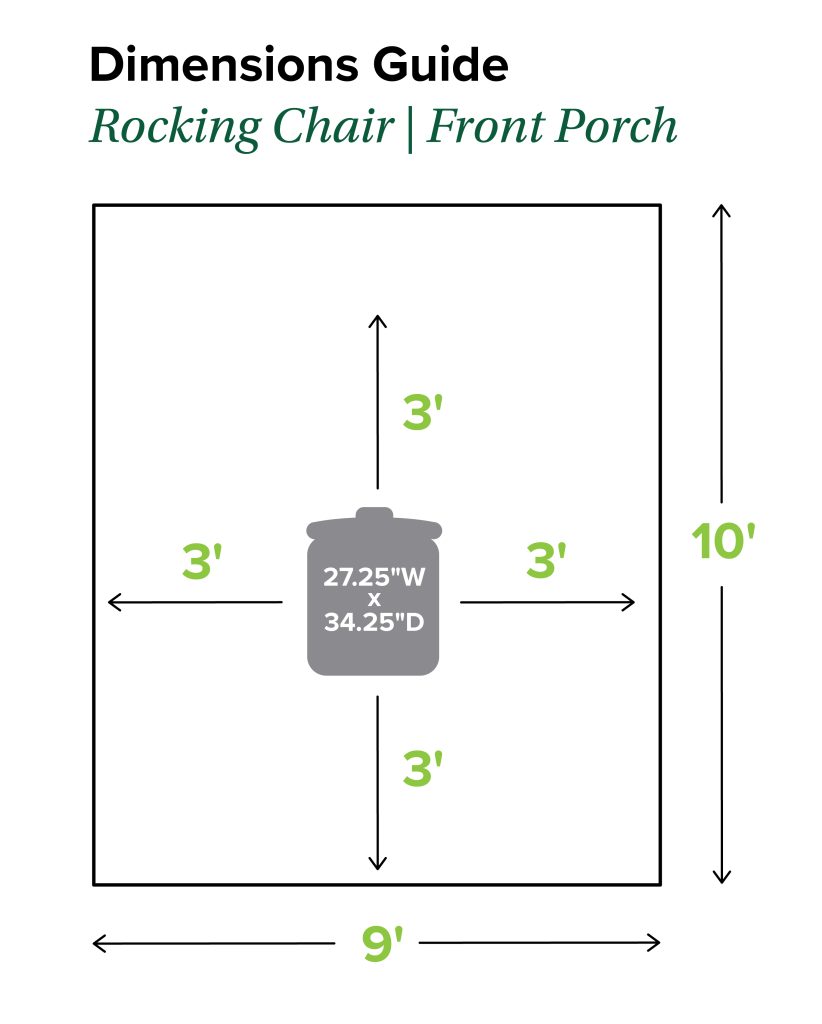
We recommend 2–3 feet of free space on all sides of your rocking chairs. This prevents them from bumping walls and other furniture and gives family plenty of room to walk by. To figure out how much room you need, start with the dimensions of a rocking chair and measure outward on all sides.
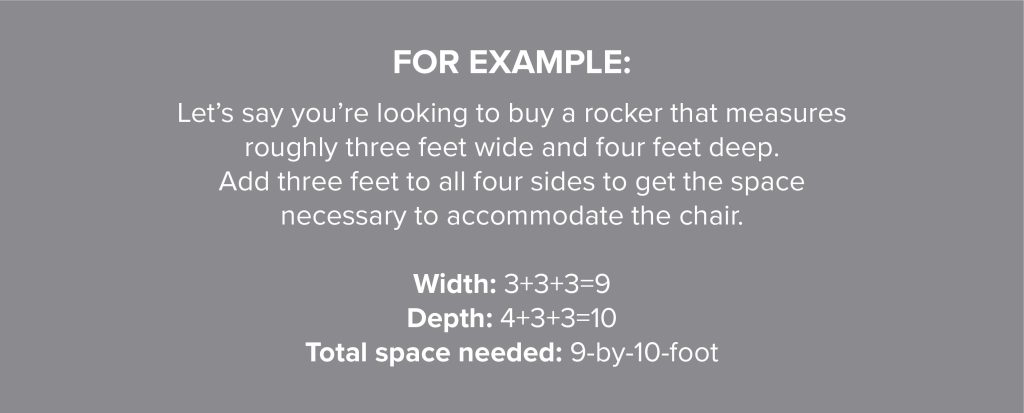
Step 3: Decide on a Material Type

In today’s market, rocking chairs are built from different materials, such as high-density polyethylene (HDPE), hardwoods, wicker, and more. We’ve broken down the features of some of the most popular materials to help you along your shopping journey.
Hardwoods
Rocking chairs were first built from wood, and hardwoods like teak and oak are popular because of their beauty and durability.
- Hardwoods are resistant to scratches and dents.
- Regular refinishing is required to keep hardwood in peak condition.
- The cost of hardwood is higher due to its rarity.
- Hardwood is weather-, corrosion-, and wind-resistant.
Softwoods
Softwoods like pine grow quickly, making them inexpensive and accessible options for rocking chairs.
- Softwood dents and scratches easily.
- Frequent upkeep is needed to protect softwoods against moisture, humidity, stains, and pests.
- Softwood rockers are less expensive than those built from hardwood.
- Though not as heavy as hardwood, softwood has plenty of heft to be wind resistant.
Natural Wicker
Wicker is a weaving technique that dates back thousands of years to ancient Egypt. Natural wicker furniture is woven from flexible, vine-like materials such as willow branches, bamboo, or rattan.
- Wicker is lightweight, making it easy to move but vulnerable to wind gusts.
- All those tiny spaces between the weave make cleaning tedious and time-intensive.
- Woven rockers do not get too hot or cold in extreme temperatures.
- Wicker needs constant upkeep to prevent breakage and protect against stains, fading, and weather.
Synthetic Wicker
Synthetic wicker furniture is woven just like its natural cousin, but manufactured materials like HDPE and nylon are used.
- Synthetic wicker is resistant to moisture, humidity, stains, and insects.
- This material is heavier than natural wicker, but it’s still easy to move.
- Synthetic wicker stays at a comfortable temperature in any climate.
- Cleaning can take time due to the weave’s nooks and crannies.
HDPE
HDPE is a durable plastic used to build various outdoor and indoor items like fencing, milk jugs, detergent bottles, and furniture.
- HDPE is resistant to wind, water, corrosion, stains, and pests.
- Cleaning HDPE rockers takes minimal time and effort.
- HDPE is designed to last for decades, and the steeper price reflects this.
- No painting, staining, sanding, or waterproofing is needed to keep HDPE in great shape.
Aluminum
Aluminum is a good option for rocking chairs because of its lower price point and easy upkeep.
- Aluminum is lightweight and easy to maneuver but cannot withstand strong winds.
- Aluminum is resistant to rust, fading, and pests, but needs regular treatment to resist corrosion and stains.
- Rockers built from aluminum require minimal cleaning.
- This material can become uncomfortable if left in direct sun for too long.
Injection-Molded Plastic
An injection-molded plastic rocker is made by filling a closed metal mold with molten plastic. The chair is removed from the mold once it’s cooled and hardened, then it’s ready to go.
- This mass-production method creates furniture that’s inexpensive and easily accessible.
- Injection-molded plastic is prone to warping and cracking in extreme temperatures.
- Rockers made from this material are water-, corrosion-, and rust-resistant.
- This material is incredibly lightweight, making it vulnerable to strong winds.
Step 4: Choose a Style That Fits Your Space
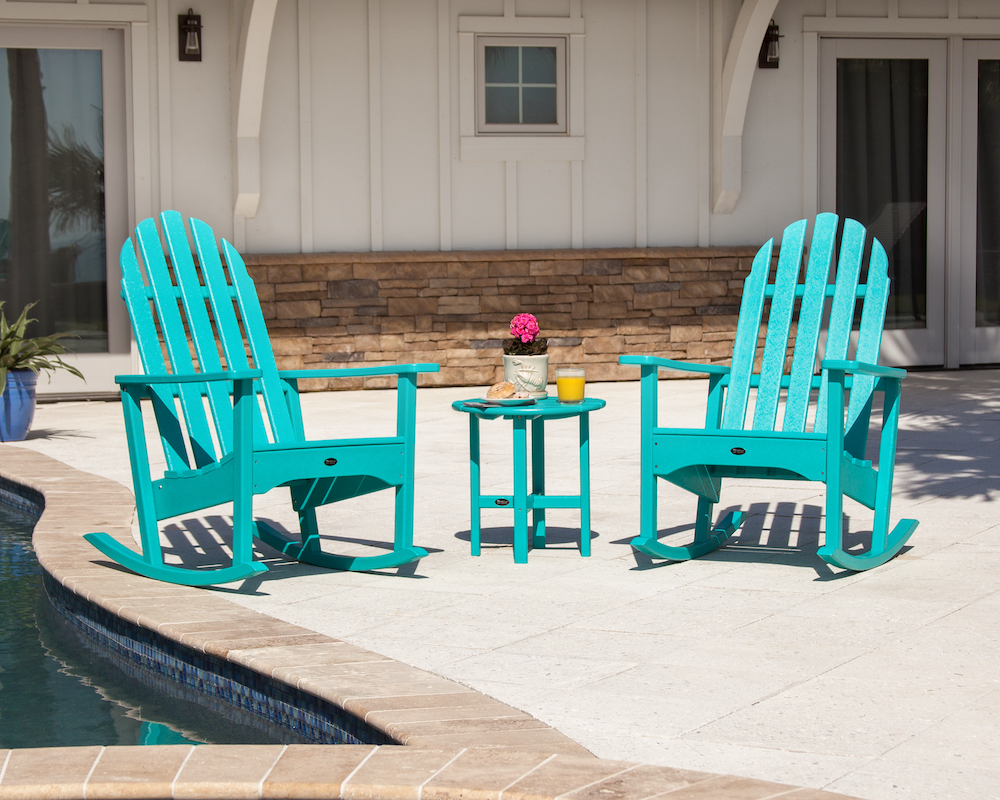
Take a good look around your outdoor setting to see your style, then select a rocking chair that naturally merges with it. A laid-back and beachy rocker might be the best fit if you live in a coastal climate. Rustic rockers work in farmhouse and cabin locales. Sleek, angular seats are great options for modern spaces with minimal details.
Step 5: Pick the Right Color
In addition to style, the right shade for your rocker will make a huge difference in how it fits into your outdoor space. Pick colors that match your home’s current palette, such as charcoal or black, to contrast a light grey and white setting. Dark greens and browns work on warm-toned decks overlooking wooded areas or gardens. You could even spring for bright hues to add pops of color to rooms with calm beiges and tans.
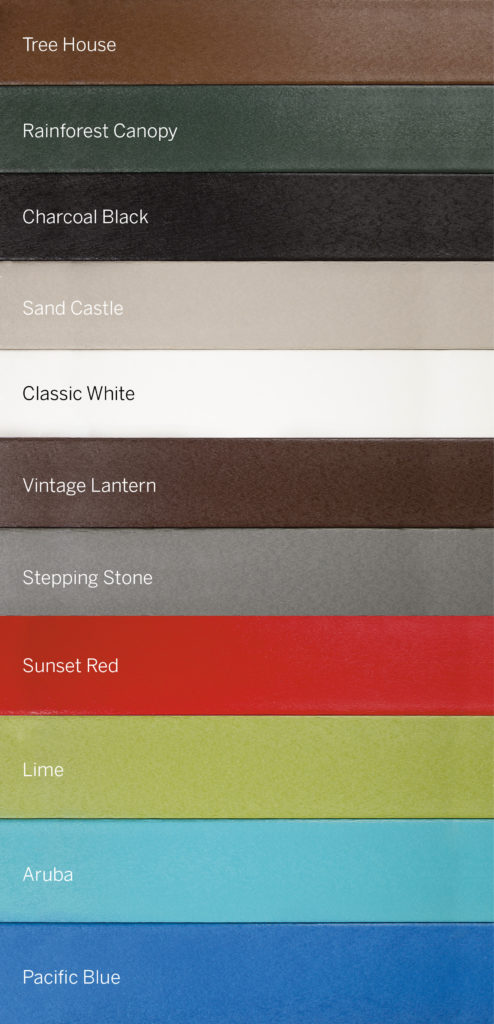
Step 6: Accessorize
Your rocking chair will provide hours of extended comfort if you include some extra padding. Invest in a seat cushion tailored in outdoor fabric so you can enjoy additional color and comfort for the long term. High-quality outdoor fabric retains color and withstands wind and rain so that you can leave cushions on your rocker regardless of the weather.

If your outdoor setting is exposed to direct sunlight, install a patio umbrella beside your rocker to add much-needed shade. Look for umbrellas with outdoor fabric canopies and durable bases that can endure the elements so you don’t have to.
Trex Outdoor Furniture Rocker Comparison
Get a feel for all the rockers we offer—we’re sure you’ll find something that catches your eye.
Yacht Club Collection
Ocean breezes and ice-cold drinks on the upper deck come to mind when imagining the Yacht Club Collection. Featuring clean lines, contoured seats, and convenient cutout headrest handles, this all-weather assemblage will have your family fully relaxed in no time.
|
|
|
|
Cape Cod Collection
A new spin on timeless New England style, the Cape Cod Collection’s aesthetic is defined by clean-lined silhouettes, gently scalloped headrests, and open-slat frames that let the sea breeze in.










Trying to decide between the Cape cod rocker and the yatch club rocker. What things should i consider ?
do you have a side by side comparison?
Which style do you get the best feedback as far a comfort.
Thanks
Hi Bill,
Thank you for reaching out to us! The rocking chairs are going to be very comparable in the overall dimensions. The Cape Cod Rocking Chair will have a more relaxed rocking experience. While the Yacht Club will sit more straight up. If you’re wanting a more relaxed rocking incline, I would suggest the Cape Cod Rocking Chair.
Here are the dimensions for the Yacht Club Rocking Chair and the Cape Cod.
https://www.trexfurniture.com/yacht-club-rocking-chair.html
https://www.trexfurniture.com/cape-cod-porch-rocking-chair-txr140.html
Thank you!
Trying to decide between the Cape cod rocker and the yatch club rocker. What things should i consider ?
Hi Bill,
Thank you for reaching out to us! The rocking chairs are going to be very comparable in the overall dimensions. The Cape Cod Rocking Chair will have a more relaxed rocking experience. While the Yacht Club will sit more straight up. If you’re wanting a more relaxed rocking incline, I would suggest the Cape Cod Rocking Chair.
Here are the dimensions for the Yacht Club Rocking Chair and the Cape Cod.
https://www.trexfurniture.com/yacht-club-rocking-chair.html
https://www.trexfurniture.com/cape-cod-porch-rocking-chair-txr140.html
Thank you!
I am interested in a new porch rocker. I think I have decided on the Cape Cod white. Does it lean far back when upright?
Hi Kathie,
Thanks for asking!
The Cape Cod Porch Rocking Chair has a slight recline, which is perfect for relaxing without being too far back.
Have a wonderful day!
I have an 8 feet by 8 feet space on my back porch. Which two rocking chairs and table would fit this space best?